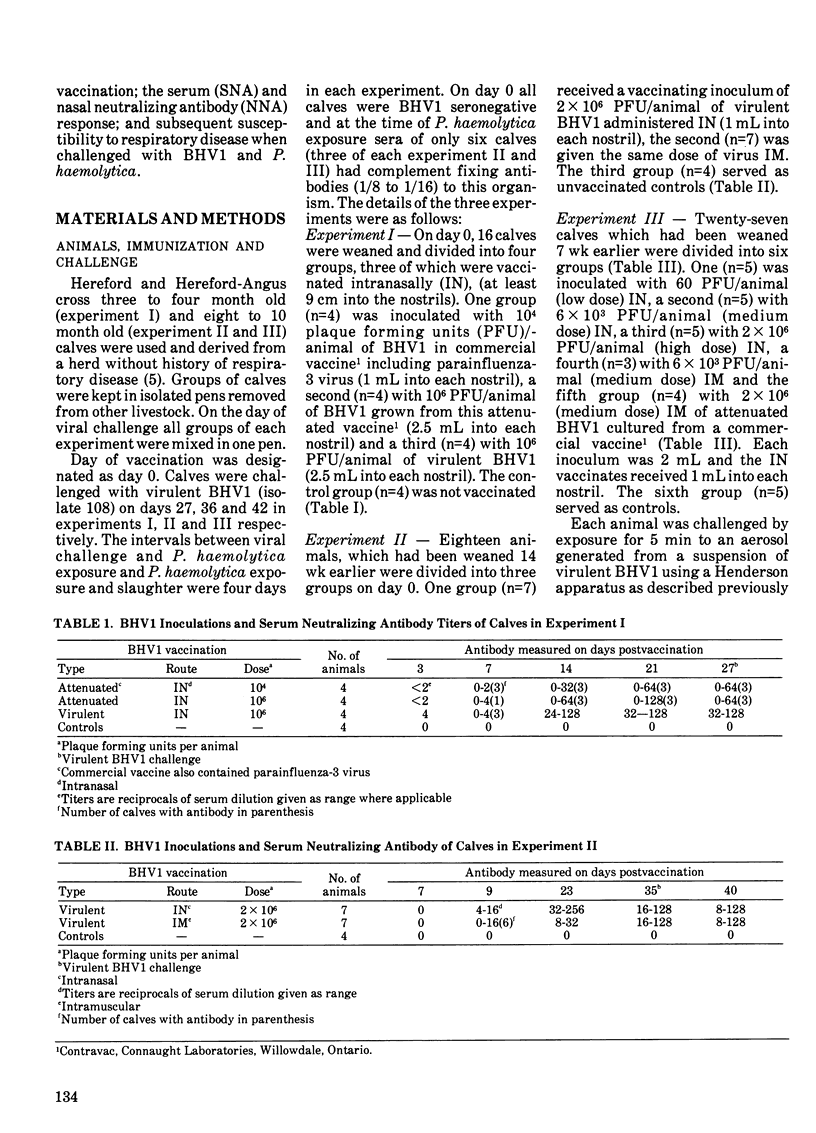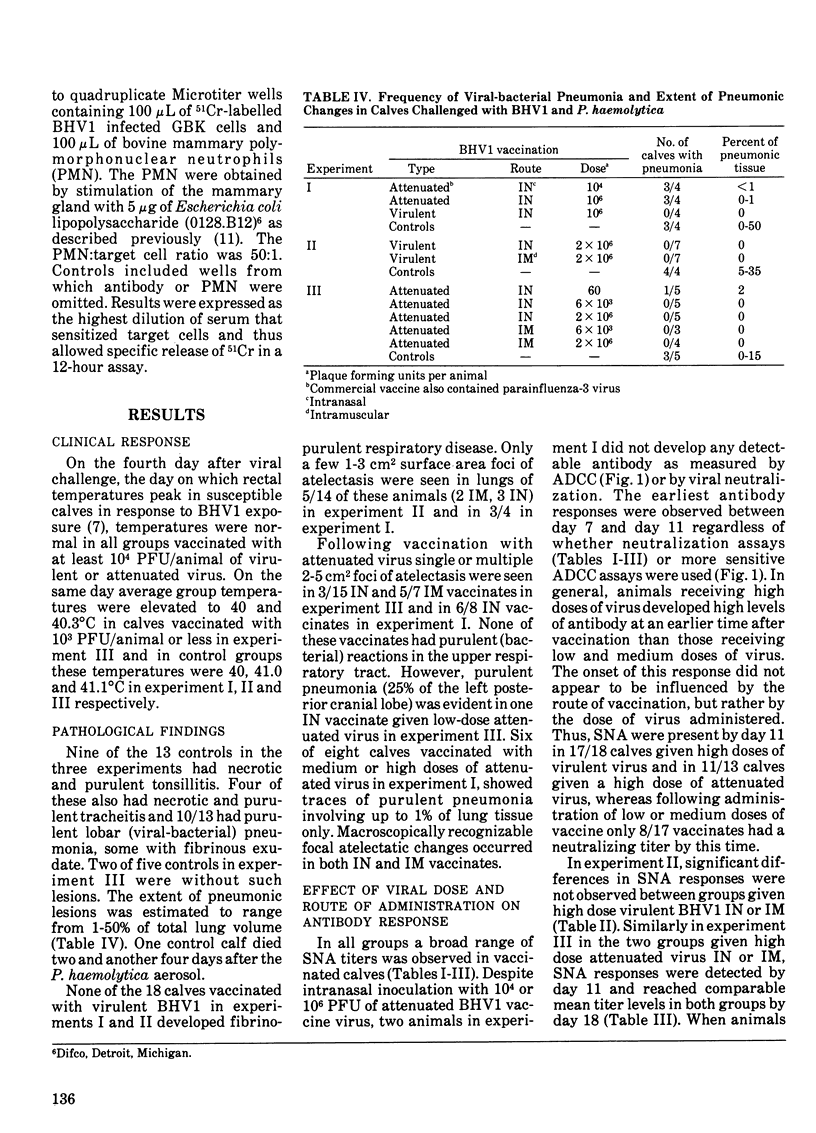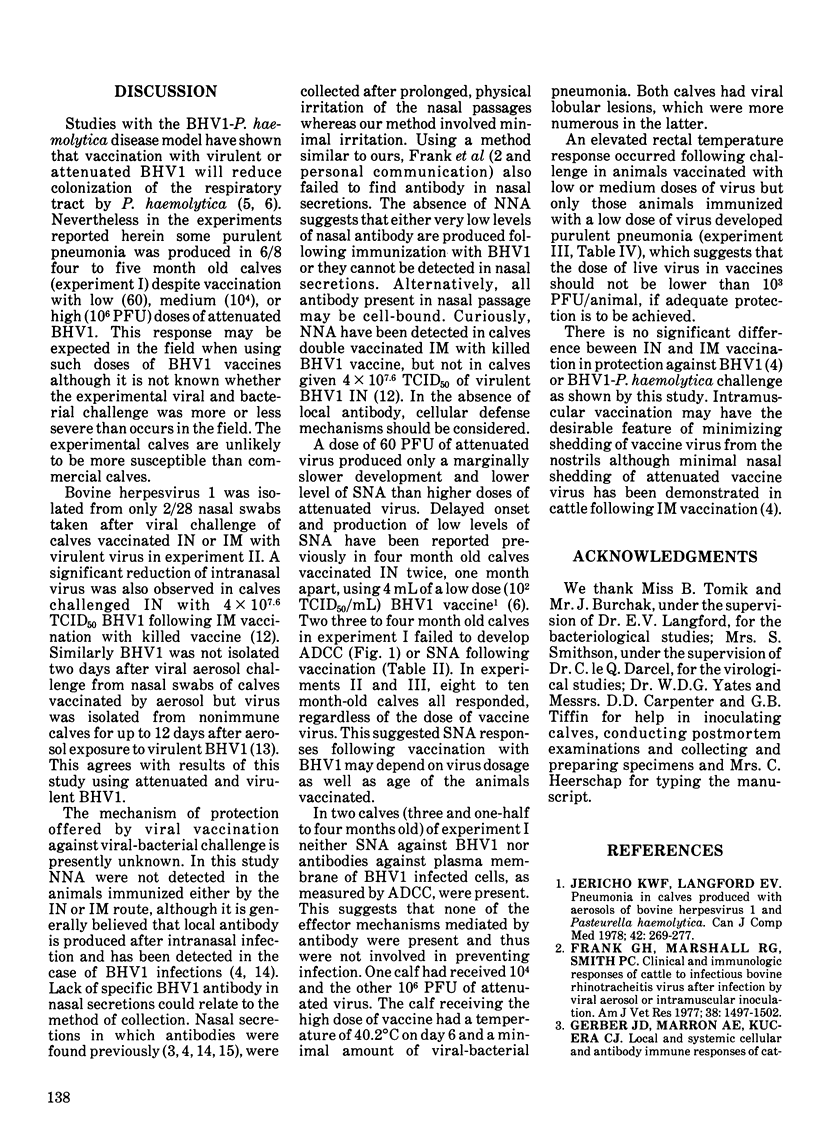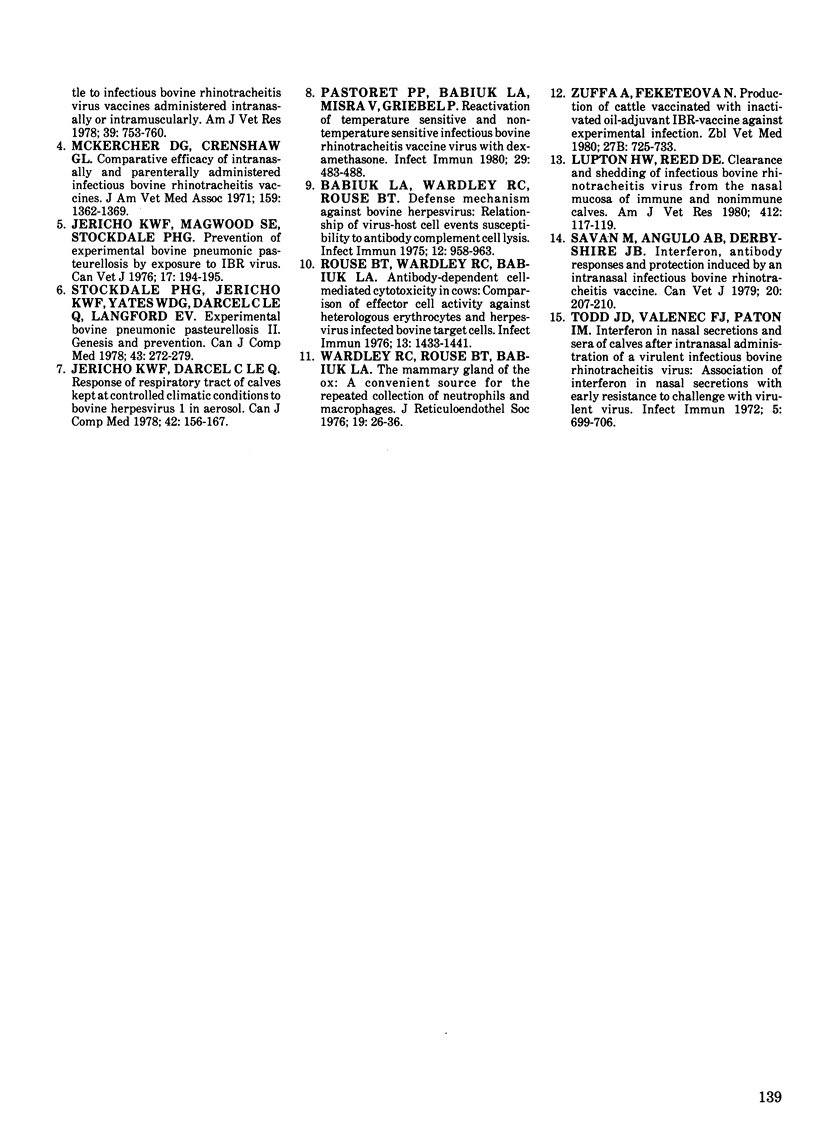Abstract
Three experiments were conducted with calves in which, following intramuscular or intranasal vaccination with virulent or attenuated bovine herpesvirus 1, calves were protected against bovine herpesvirus 1 -- Pasteurella haemolytica challenge. Calves receiving low doses of vaccine had lower levels of antibody and greater evidence of virus replication upon challenge than those receiving higher doses. In contrast 11/13 unvaccinated controls had fibrino-purulent pneumonia following challenge. The immune response developed later in younger calves and those given low doses of vaccine. Neutralizing antibodies to bovine herpes-virus 1 were not found in nasal secretions, but were present in serum seven days after vaccination. Bovine herpesvirus 1 was isolated before challenge from nasal secretions of calves vaccinated intranasally or intramuscularly with virulent virus but not those vaccinated intramuscularly with vaccine virus. It was concluded that both routes of vaccination with either virulent or attenuated bovine herpesvirus 1 provided protection from challenge with homologous or heterologous bovine herpesvirus 1 and that live vaccines should contain at least 10(3) plaque forming units/dose for effective immunization.
Full text
PDF






Selected References
These references are in PubMed. This may not be the complete list of references from this article.
- Babiuk L. A., Wardley R. C., Rouse B. T. Defense mechanisms against bovine herpesvirus: relationship of virus-host cell events to susceptibility to antibody-complement cell lysis. Infect Immun. 1975 Nov;12(5):958–963. doi: 10.1128/iai.12.5.958-963.1975. [DOI] [PMC free article] [PubMed] [Google Scholar]
- Frank G. H., Marshall R. G., Smith P. C. Clinical and immunologic responses of cattle to infectious bovine rhinotracheitis virus after infection by viral aerosol or intramuscular inoculation. Am J Vet Res. 1977 Oct;38(10):1497–1502. [PubMed] [Google Scholar]
- Gerber J. D., Marron A. E., Kucera C. J. Local and systemic cellular and antibody immune responses of cattle to infectious bovine rhinotracheitis virus vaccines administered intranassally or intramuscularly. Am J Vet Res. 1978 May;39(5):753–760. [PubMed] [Google Scholar]
- Jericho K. W., Darcel C. Q. Response of the respiratory tract of calves kept at controlled climatic conditions to bovine Herpesvirus 1 in aerosol. Can J Comp Med. 1978 Apr;42(2):156–167. [PMC free article] [PubMed] [Google Scholar]
- Jericho K. W., Langford E. V. Pneumonia in calves produced with aerosols of bovine herpesvirus 1 and Pasteurella haemolytica. Can J Comp Med. 1978 Jul;42(3):269–277. [PMC free article] [PubMed] [Google Scholar]
- Jericho K. W., Magwood S. E., Stockdale P. H. Letter to the editor: Prevention of experimental bovine pneumonic pasteurellosis by exposure to IBR virus. Can Vet J. 1976 Jul;17(7):194–195. [PMC free article] [PubMed] [Google Scholar]
- Lupton H. W., Reed D. E. Clearance and shedding of infectious bovine rhinotracheitis virus from the nasal mucosa of immune and nonimmune calves. Am J Vet Res. 1980 Jan;41(1):117–119. [PubMed] [Google Scholar]
- McKercher D. G., Crenshaw G. L. Comparative efficacy of intranasally and parenterally administered infectious bovine rhinotracheitis vaccines. J Am Vet Med Assoc. 1971 Dec 1;159(11):1362–1369. [PubMed] [Google Scholar]
- Pastoret P. P., Babiuk L. A., Misra V., Griebel P. Reactivation of temperature-sensitive and non-temperature-sensitive infectious bovine rhinotracheitis vaccine virus with dexamethasone. Infect Immun. 1980 Aug;29(2):483–488. doi: 10.1128/iai.29.2.483-488.1980. [DOI] [PMC free article] [PubMed] [Google Scholar]
- Rouse B. T., Wardley R. C., Babiuk L. A. Antibody-dependent cell-mediated cytotoxicity in cows: comparison of effector cell activity against heterologous erthrocyte and herpesvirus-infected bovine target cells. Infect Immun. 1976 May;13(5):1433–1441. doi: 10.1128/iai.13.5.1433-1441.1976. [DOI] [PMC free article] [PubMed] [Google Scholar]
- Savan M., Angulo A. B., Derbyshire J. B. Interferon, antibody responses and protection induced by an intranasal infectious bovine rhinotracheitis vaccine. Can Vet J. 1979 Aug;20(8):207–210. [PMC free article] [PubMed] [Google Scholar]
- Stockdale P. H., Jericho K. W., Yates W. D., Darcel C., Langford E. V. Experimental bovine pneumonic pasteurellosis. II. Genesis and prevention. Can J Comp Med. 1979 Jul;43(3):272–279. [PMC free article] [PubMed] [Google Scholar]
- Todd J. D., Volenec F. J., Paton I. M. Interferon in nasal secretions and sera of calves after intranasal administration of avirulent infectious bovine rhinotracheitis virus: association of interferon in nasal secretions with early resistance to challenge with virulent virus. Infect Immun. 1972 May;5(5):699–706. doi: 10.1128/iai.5.5.699-706.1972. [DOI] [PMC free article] [PubMed] [Google Scholar]
- Wardley R. C., Rouse B. T., Babiuk L. A. The mammary gland of the ox: a convenient source for the repeated collection of neutrophils and macrophages. J Reticuloendothel Soc. 1976 Jan;19(1):29–36. [PubMed] [Google Scholar]
- Zuffa A., Feketeová N. Protection of cattle vaccinated with inactivated oil-adjuvant IBR-vaccine against experimental infection. Zentralbl Veterinarmed B. 1980;27(9-10):725–733. doi: 10.1111/j.1439-0450.1980.tb02027.x. [DOI] [PubMed] [Google Scholar]


